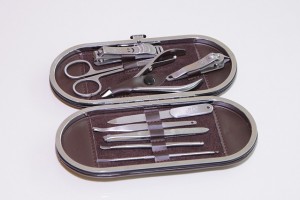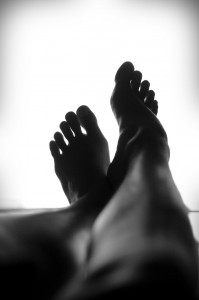Most women will agree that a pedicure is an absolute must before flaunting their feet in flirty, summer sandals. So, it’s no wonder that all through the warmer months, salons do brisk business with clients seeking “manis and pedis“.
In the midst of all the excitement, safety and hygiene inevitably take a back seat and the consequences are utterly horrifying:
Nearly half of all nail fungus and foot infection cases can be traced back to unhygienic pedicures.
Fortunately, if you don’t want to go from salon to surgery, all you have to do is learn about pedicure health risks and ways to avoid them.
Table of Contents
Are pedicures really all that dangerous?
 Foot pampering sessions have garnered legions of devoted fans. After all, who does not enjoy having their feet soaked in warm water and then given a good rubbing down that draws out all the fatigue and pain?
Foot pampering sessions have garnered legions of devoted fans. After all, who does not enjoy having their feet soaked in warm water and then given a good rubbing down that draws out all the fatigue and pain?
However, all that trimming and scrubbing can cause serious trouble.
The wounds
Typically, the pedicurist trims your nails, pushes back the cuticles, cuts the excess skin and gives the soles of your feet a thorough scrubbing with a pumice stone.
Through all of this, it is very easy to cause tiny wounds and cuts. For example, many women have lost a few drops of blood when the cuticle cutting is taken too far or from lacerations on the soles caused by hard pumice stones.
The shoddy hygiene practices
Unfortunately, salon professionals seldom wait to disinfect these open wounds. At the most, you are given a band aid. However, the tiny wounds turn into infection points since foot spas and pedicure baths are rarely sanitized the way they should be.
The same goes for the cuticle cutters, nail clippers, pumice stones and other tools which often go from one client to another without being disinfected. The result is that fungus and bacteria quickly spread from one host to another.
From pampering to punishment all in a day’s experience for the pedicure aficionado!
If you are wondering just how bad these infections can be, here are a few examples:
- A lady in Toronto spent almost a month getting several surgical procedures done to battle away the infection she had contracted after a pedicure.
- Another woman had to get her toe nail surgically removed because the nail fungus infection was not responding to regular antibiotics.
- A third patron needed plastic surgery after extensive tissue damage caused by an infected wound that resulted from pumice stone scrubbing.
- A 46 year old woman in Texas died from complications caused by a staph infection, which again was a result of an unhygienic pedicure.
- There are also two documented cases of ladies getting infected with fatal flesh eating bacteria after going through a pedicure.
Those who have a compromised immune systems, circulatory and cardiovascular problems and diabetes are particularly at risk. So, if you suffer from any of these ailments, it is best to stay away from pedicures and visit your podiatrist instead.
But, there is hope for the rest of us!
 It is your health which is at stake, so only you can ensure that you get the most hygienic treatment for the money you offer.
It is your health which is at stake, so only you can ensure that you get the most hygienic treatment for the money you offer.
Follow these 7 tips and you will be able to keep pedicure health risks at bay:
Don’t allow any compromise on hygiene
Watch for unhygienic practices like a hawk. Visit the salon a good half an hour before your appointment, so you get enough time to see if the foot spas and the tools are thoroughly disinfected after every use.
If they are using a liquid disinfectant, ask to see it. This way you can ensure that the product is an antibacterial and antifungal agent. Also, check if the tools are allowed to sit in a bath of the liquid for 15-20 minutes.
Pedicure baths are the most unhygienic
Whirlpool foot baths are breeding grounds for microorganism that cause warts, athlete’s foot and other foot infections. So, it is best to get the pedicure done at a salon that uses individual bath liner and has pipe-less foot spas. Also, make sure that these foot spas are sanitised for no less than 10 minutes after every use.
Non-metal tools should be discarded
Non-metal tools that cannot be sterilised such as nail buffers, nail files and pumices should be discarded. In some salons, individual nail care kits are handed over to the clients after use, so they can bring it along on their next visit. If this is not how your pedicurist handles these tools, maintain your own kit that you can take along to the salon. This way you can be sure that infected non-metal tools are not used on you.
Microorganisms thrive in wet and warm environment
Ask the pedicurist to thoroughly dry the skin in between your toes. This helps to prevent the growth of fungus and bacteria. If you have had a problem with such issues in the past, apply antifungal powder to prevent infections.
Choose the right cut
Round nails are trouble waiting to happen as they usually grow into the skin. The best way to avoid the risk of ingrown nails is to cut toenails straight across with no contouring in the corners. As far as cuticles are concerned, podiatrists recommend that you just leave them alone. No pushing back or cutting the excess skin as this often opens a doorway for bacterial infections.
Never go for a pedicure if you have an open wound
It can be a shoe bite, bug bite or any small wound; avoid pedicures entirely till the wound does not completely heal. In fact, don’t go for a pedicure if you have just shaved, waxed or epilated your legs. The microtears caused by the razor blades will introduce bacteria right into the skin. So, don’t shave your legs for two days before your pedicure appointment and put at least 24 hours between a waxing session and a pedicure.
Avoid those ghastly fish pedicures
No matter what they say about this but fish pedicures are utterly dangerous. Imagine fishes nibbling at your feet and opening a pathway for bacteria from the water polluted with marine excrement to enter your skin. If you think this is going to end up with you having softer, smoother feet, you could not be more wrong. Yes, you may end up in the hospital.
Finally, avoid busy days and special deals because these attract a larger number of clients, making hygiene slip-ups and pedicure health risks more common. Also, take a good look around you. If the salon is cluttered and the tools, linen and brushes are strewn across counters without being covered, this should give you enough reason to walk out and visit another establishment.





, you can pair it with almost anityhng. When I go to a salon, I usually just have manicure and pedicure minus the nail polish, but sometimes i have my nails colored when there’s a special occasion.
I am sure to some degree they can be dangerous. One of the things that I think about a lot would be whether or not I have someone that knows what they are doing. Its can be a little nerve racking.
pretty much rubbish advice that won’t apply to any apart from a few screamers who are always going to make a fuss whatever they have done wherever they go!
Nicky needs to get a little real and a little less “Nicky” as I would not want to aquaint myself with such a fussy-old-pot! (Personally or Professionally!)